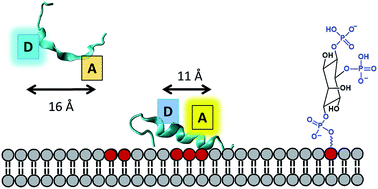当前位置:
X-MOL 学术
›
Faraday Discuss.
›
论文详情
Our official English website, www.x-mol.net, welcomes your
feedback! (Note: you will need to create a separate account there.)
Optically sensing phospholipid induced coil–helix transitions in the phosphoinositide-binding motif of gelsolin
Faraday Discussions ( IF 3.3 ) Pub Date : 2017-11-01 , DOI: 10.1039/c7fd00197e Samsuzzoha Mondal 1, 2, 3, 4 , Amitava Chandra 1, 2, 3, 4 , Ravindra Venkatramani 1, 2, 3, 4 , Ankona Datta 1, 2, 3, 4
Faraday Discussions ( IF 3.3 ) Pub Date : 2017-11-01 , DOI: 10.1039/c7fd00197e Samsuzzoha Mondal 1, 2, 3, 4 , Amitava Chandra 1, 2, 3, 4 , Ravindra Venkatramani 1, 2, 3, 4 , Ankona Datta 1, 2, 3, 4
Affiliation

|
We present a systematic experimental and computational study of phospholipid induced peptide coil–helix transitions which are relevant in the context of proteins mediating cytoskeletal rearrangement via membrane binding. We developed a sensitive Förster resonance energy transfer (FRET) based assay to address whether coil–helix transitions in phospholipid binding motifs of actin-binding proteins can be induced by physiologically-relevant concentrations (1–20 μM) of phosphatidylinositol-4,5-bisphosphate (PI(4,5)P2) phospholipids. Based on inter-residue distance constraints obtained from Molecular Dynamics (MD) simulations of a 20 residue peptide (Gel 150–169) from the actin-severing protein gelsolin, we synthetized and labeled the peptide with a tryptophan donor and IAEDANS acceptor pair. Upon addition of PI(4,5)P2 micelles and mixed vesicles containing PI(4,5)P2 and phosphatidylcholine to the peptide, we observed a decrease in the tryptophan emission intensity with increasing concentrations of PI(4,5)P2. The IAEDANS emission spectra showed a more complex profile exhibiting a blue shift of the emission peak and non-monotonic changes in the intensity profile with increasing concentrations of PI(4,5)P2. We showed that the IAEDANS acceptor emission response is a result of both intrinsic polarity sensitivity of the acceptor in the vicinity of the membrane surface and fluorescence energy transfer from the donor. Importantly, the fluorescence lifetime of the donor (tryptophan) showed a monotonous decrease with increasing mol% of PI(4,5)P2 from 1.13 ± 0.10 ns in the absence of phospholipids to 0.25 ± 0.03 ns in the presence of 100% PI(4,5)P2 micelles. We also showed a concomitant increase in FRET efficiency with increasing PI(4,5)P2 levels indicating a PI(4,5)P2 concentration dependent coil–helix transition. Our studies demonstrate that membrane PI(4,5)P2 concentrations as low as 2.5–5 μM can trigger helix–coil conformational changes in gelsolin relevant for triggering regulatory processes in the cell.
中文翻译:

光学感应凝溶胶蛋白的磷酸肌醇结合基序中的磷脂诱导的线圈-螺旋转变
我们介绍了磷脂诱导的肽螺旋-螺旋转变的系统性实验和计算研究,这与蛋白质通过介导细胞骨架重排有关膜结合。我们开发了一种敏感的基于Förster共振能量转移(FRET)的检测方法,以解决是否可以通过生理相关浓度(1– 20μM)的磷脂酰肌醇-4,5-诱导肌动蛋白结合蛋白的磷脂结合基序中的螺旋螺旋转变。双磷酸酯(PI(4,5)P2)磷脂。根据分子动力学(MD)模拟从切断肌动蛋白的蛋白质凝溶胶蛋白中残基20个残基(Gel 150–169)获得的残基间距离限制,我们合成了该肽并用色氨酸供体和IAEDANS受体对标记了该肽。向肽中添加PI(4,5)P2胶束和包含PI(4,5)P2和磷脂酰胆碱的混合囊泡后,我们观察到色氨酸发射强度随PI(4,5)P2浓度的增加而降低。IAEDANS发射光谱显示出更复杂的轮廓,随着PI(4,5)P2浓度的增加,发射峰呈现蓝移并且强度轮廓发生非单调变化。我们表明,IAEDANS受体发射响应是膜表面附近受体的固有极性敏感性和来自供体的荧光能量转移的结果。重要的是,供体(色氨酸)的荧光寿命随着PI(4,5)P2 mol%的增加(从不存在磷脂的情况下的1.13±0.10 ns)增加到在100%PI(存在)的情况下的0.25±0.03 ns而单调降低。 4,5)P2胶束。我们还显示,随着PI(4,5)P2水平的升高,FRET效率也随之提高,这表明PI(4,5)P2的浓度取决于线圈-螺旋的转变。我们的研究表明膜PI(4,
更新日期:2018-04-17
中文翻译:

光学感应凝溶胶蛋白的磷酸肌醇结合基序中的磷脂诱导的线圈-螺旋转变
我们介绍了磷脂诱导的肽螺旋-螺旋转变的系统性实验和计算研究,这与蛋白质通过介导细胞骨架重排有关膜结合。我们开发了一种敏感的基于Förster共振能量转移(FRET)的检测方法,以解决是否可以通过生理相关浓度(1– 20μM)的磷脂酰肌醇-4,5-诱导肌动蛋白结合蛋白的磷脂结合基序中的螺旋螺旋转变。双磷酸酯(PI(4,5)P2)磷脂。根据分子动力学(MD)模拟从切断肌动蛋白的蛋白质凝溶胶蛋白中残基20个残基(Gel 150–169)获得的残基间距离限制,我们合成了该肽并用色氨酸供体和IAEDANS受体对标记了该肽。向肽中添加PI(4,5)P2胶束和包含PI(4,5)P2和磷脂酰胆碱的混合囊泡后,我们观察到色氨酸发射强度随PI(4,5)P2浓度的增加而降低。IAEDANS发射光谱显示出更复杂的轮廓,随着PI(4,5)P2浓度的增加,发射峰呈现蓝移并且强度轮廓发生非单调变化。我们表明,IAEDANS受体发射响应是膜表面附近受体的固有极性敏感性和来自供体的荧光能量转移的结果。重要的是,供体(色氨酸)的荧光寿命随着PI(4,5)P2 mol%的增加(从不存在磷脂的情况下的1.13±0.10 ns)增加到在100%PI(存在)的情况下的0.25±0.03 ns而单调降低。 4,5)P2胶束。我们还显示,随着PI(4,5)P2水平的升高,FRET效率也随之提高,这表明PI(4,5)P2的浓度取决于线圈-螺旋的转变。我们的研究表明膜PI(4,











































 京公网安备 11010802027423号
京公网安备 11010802027423号